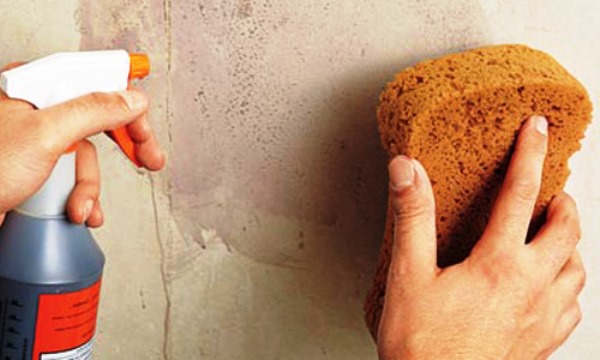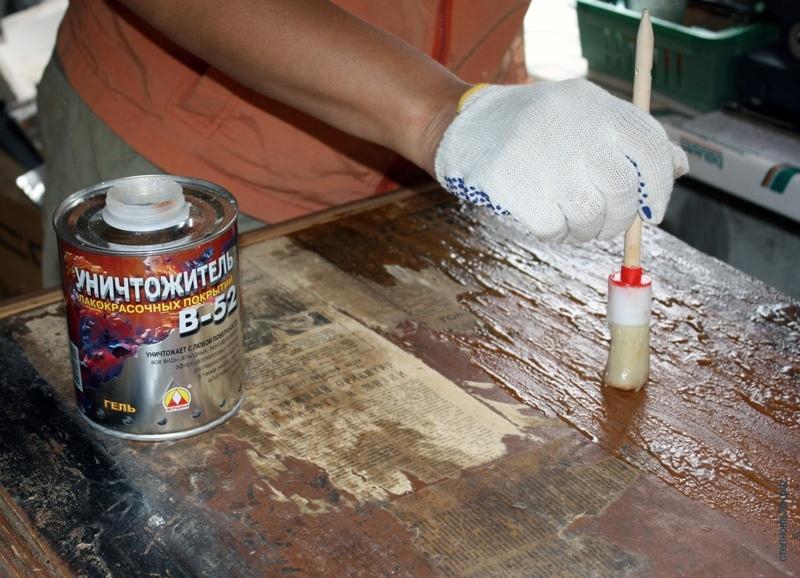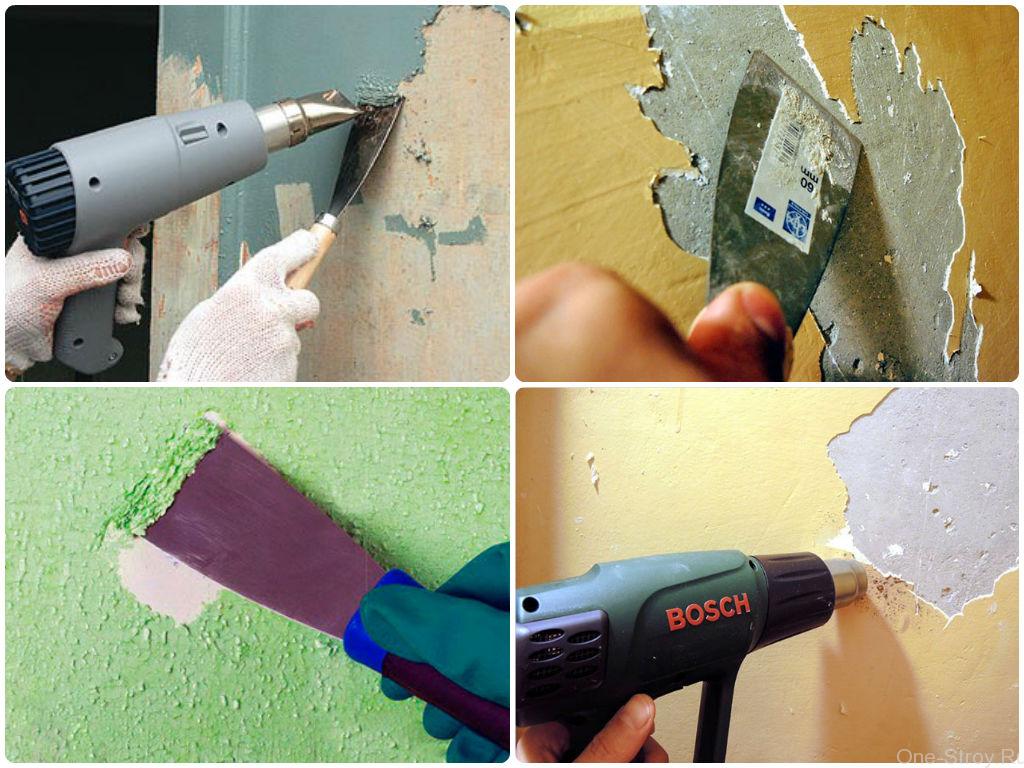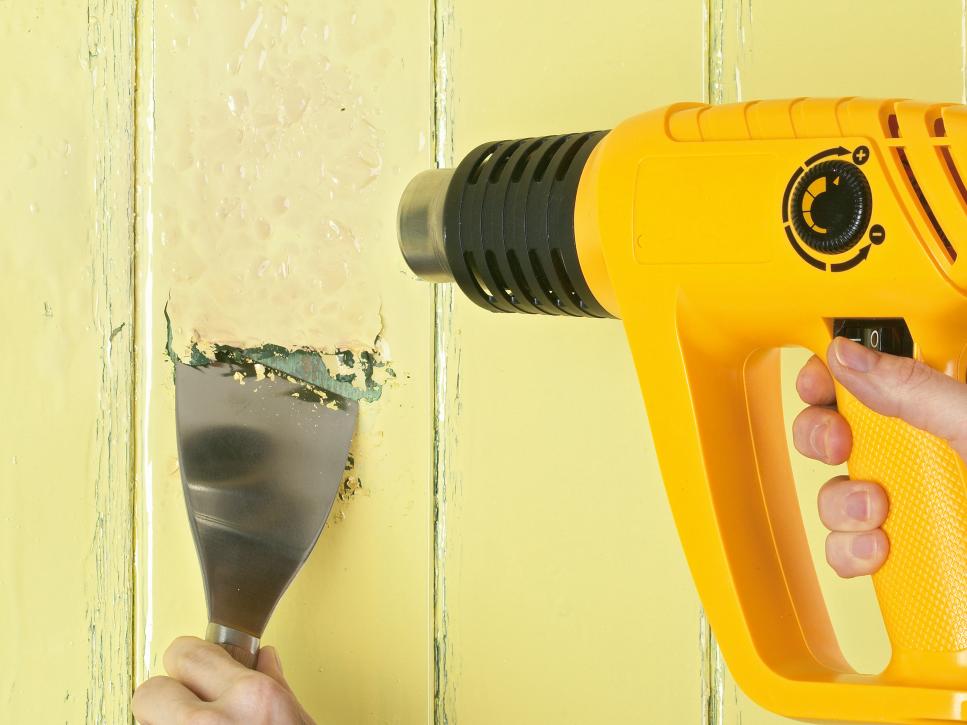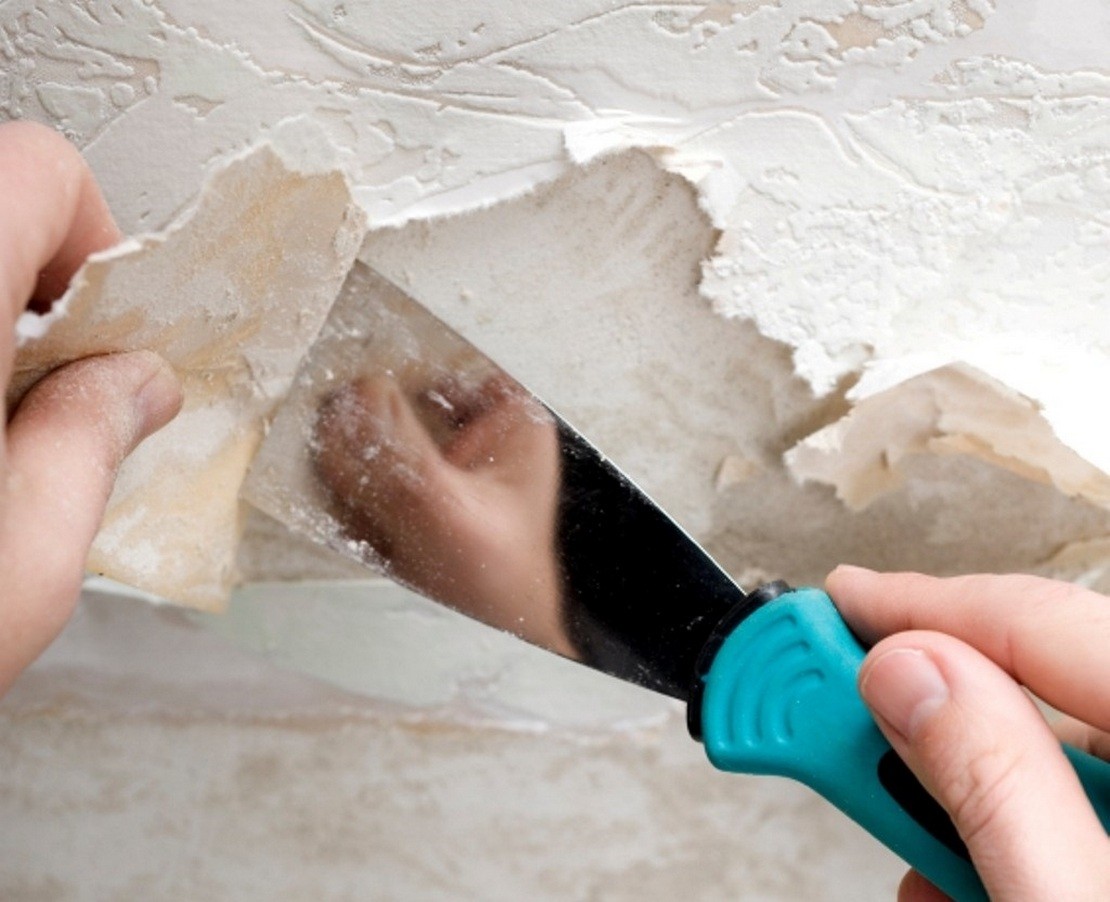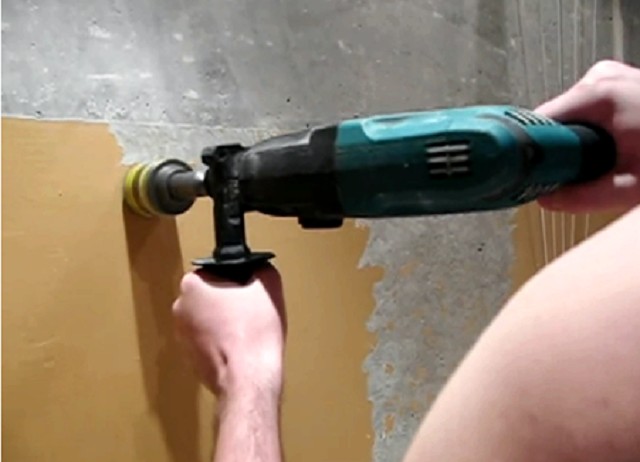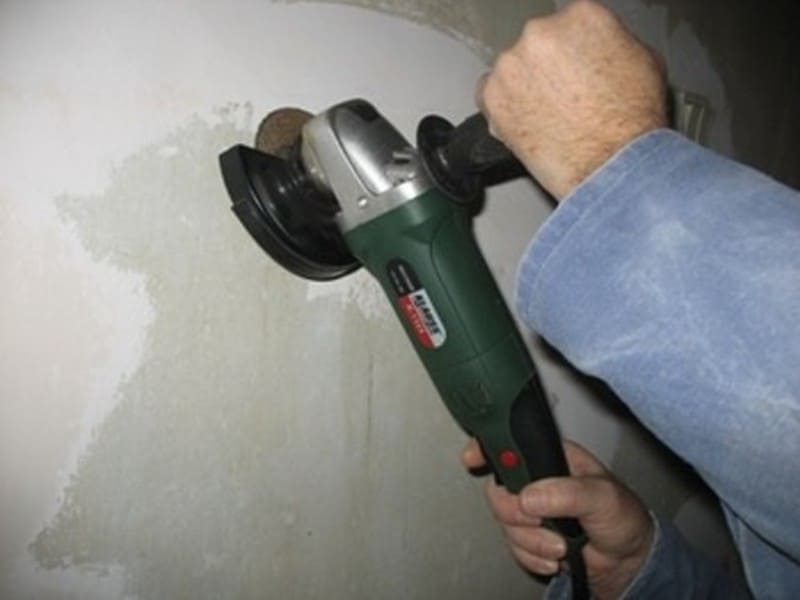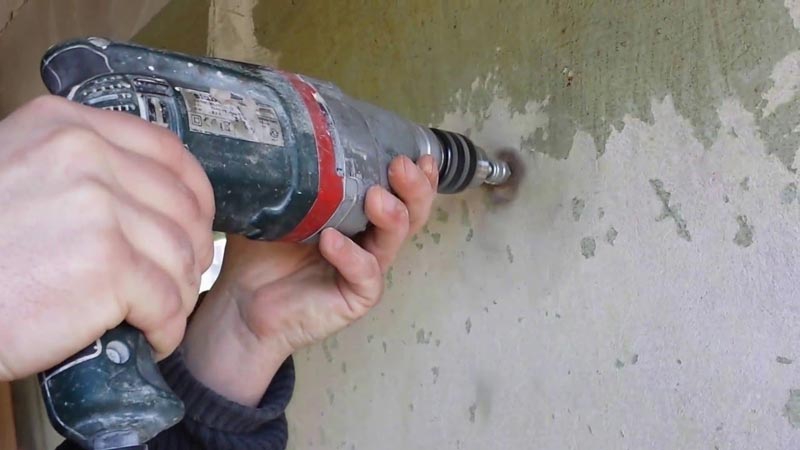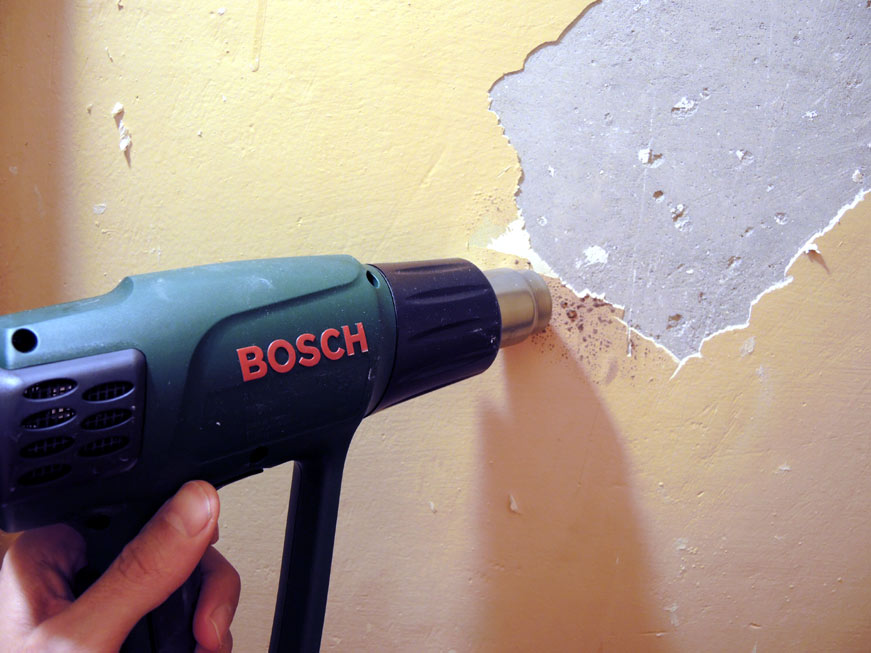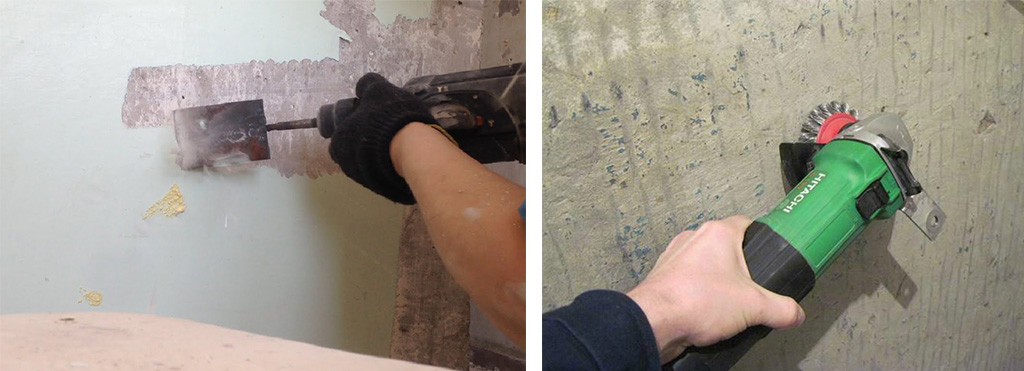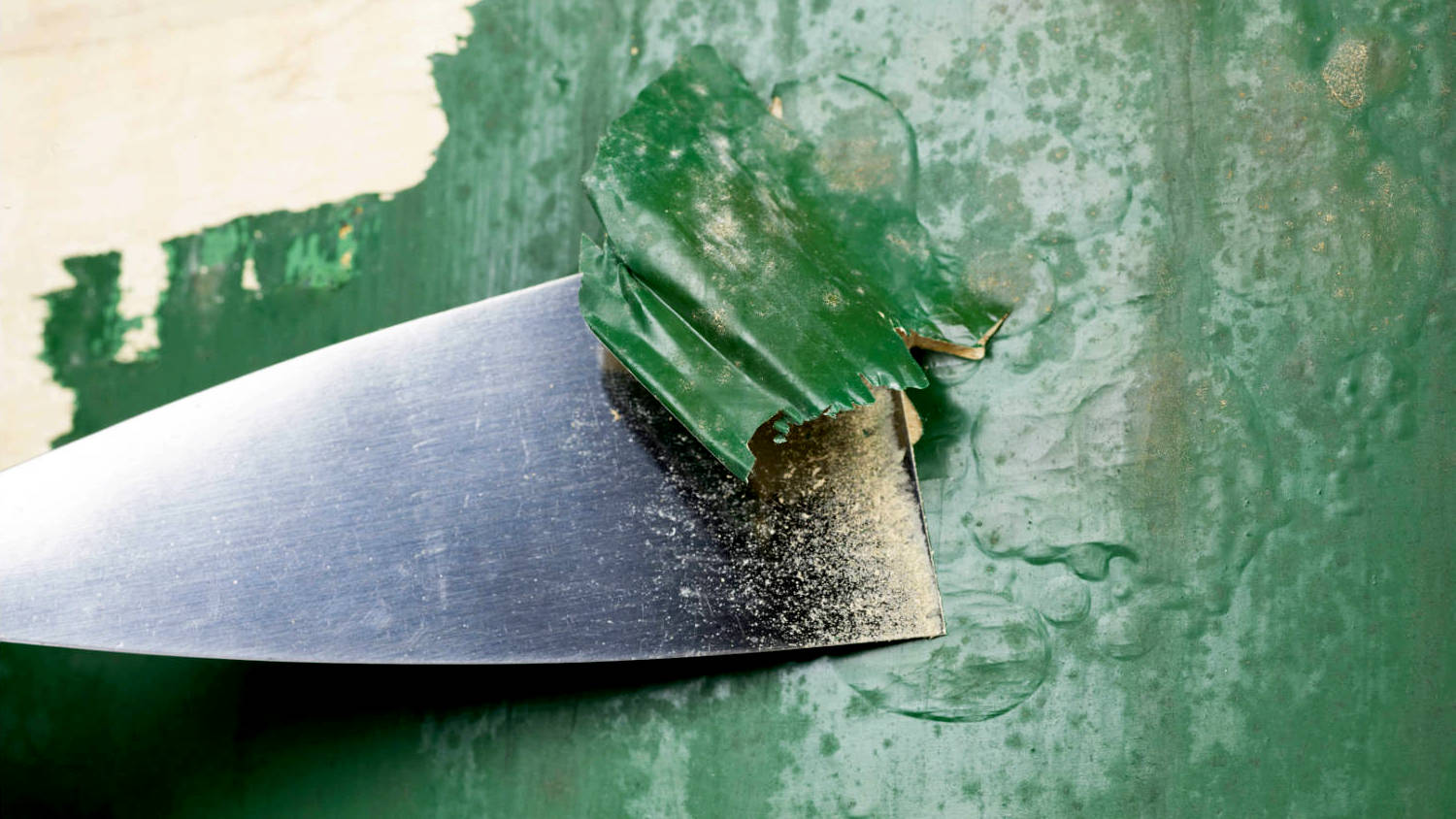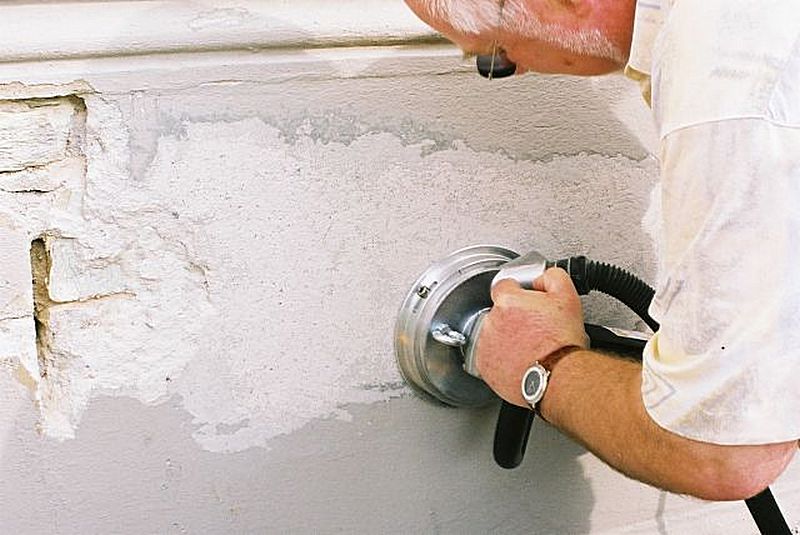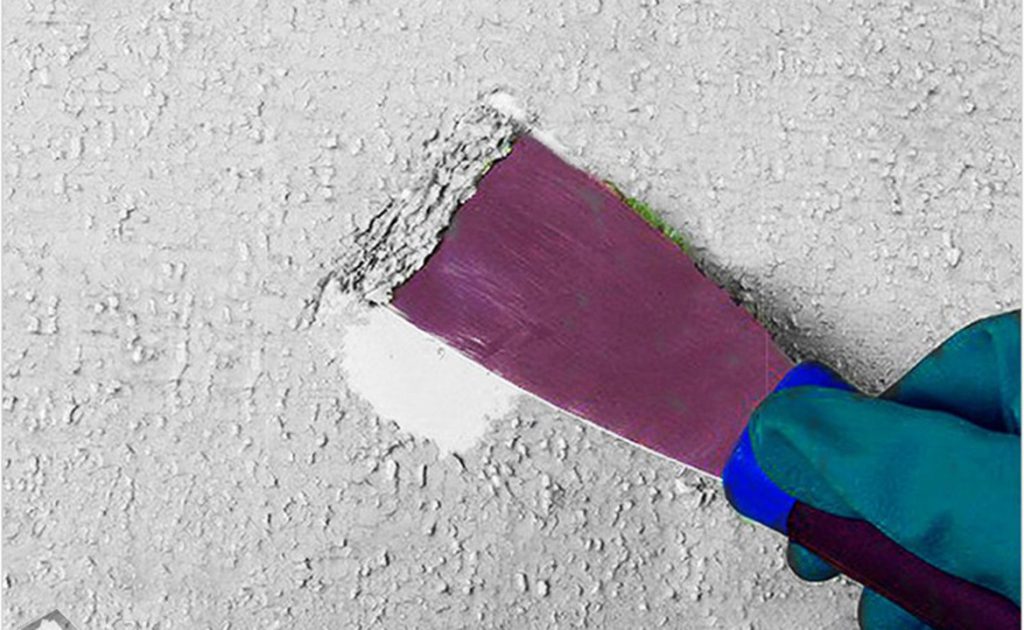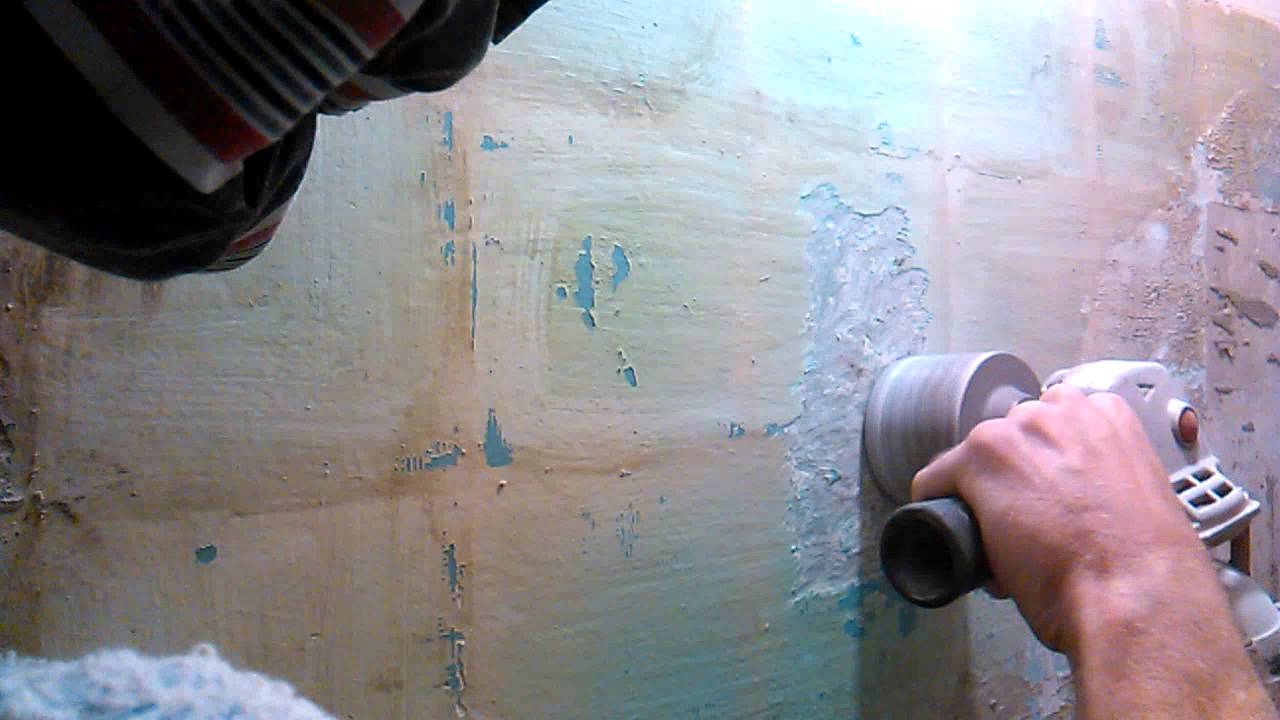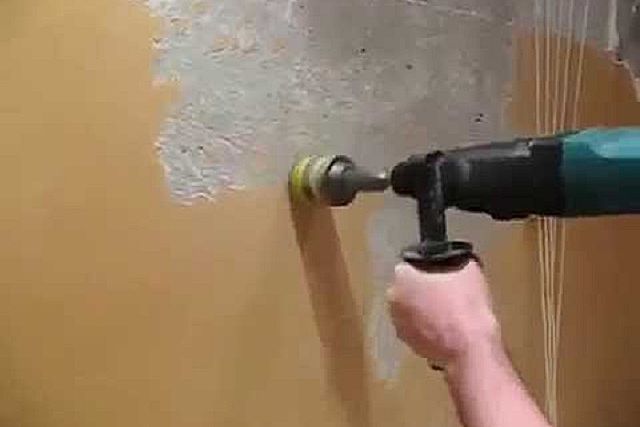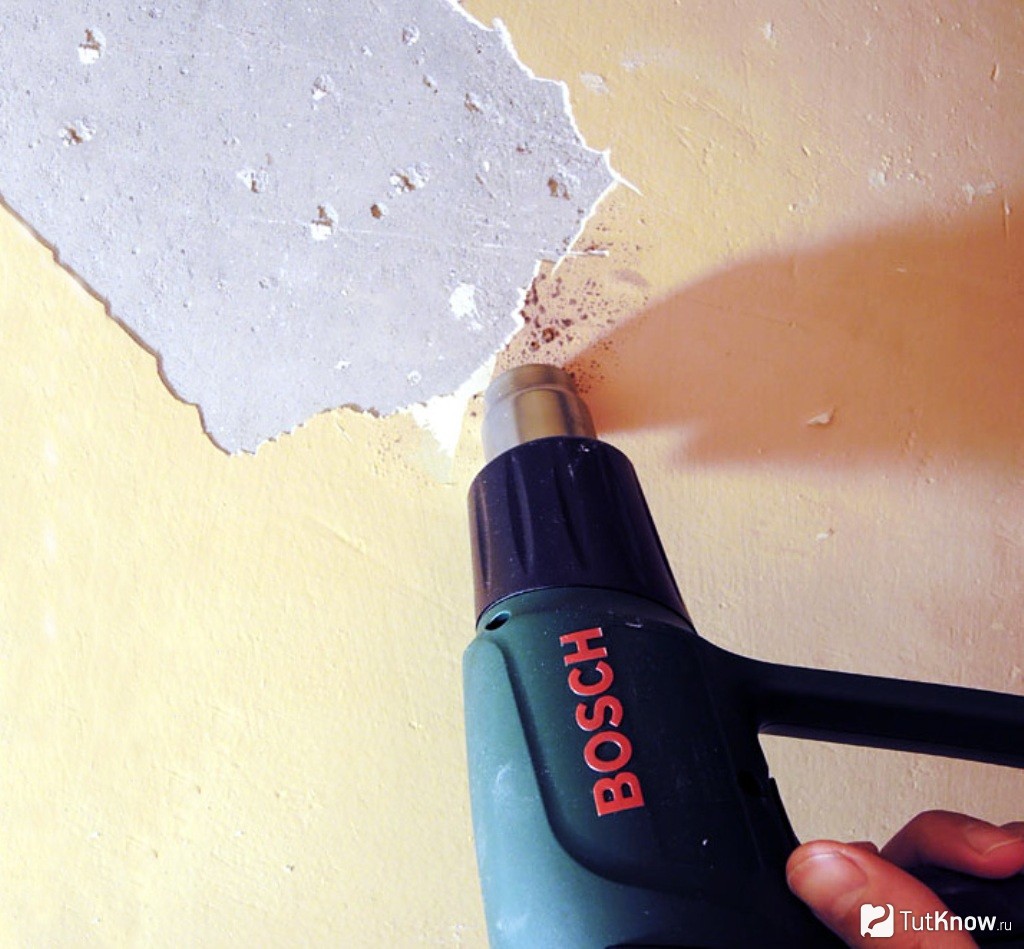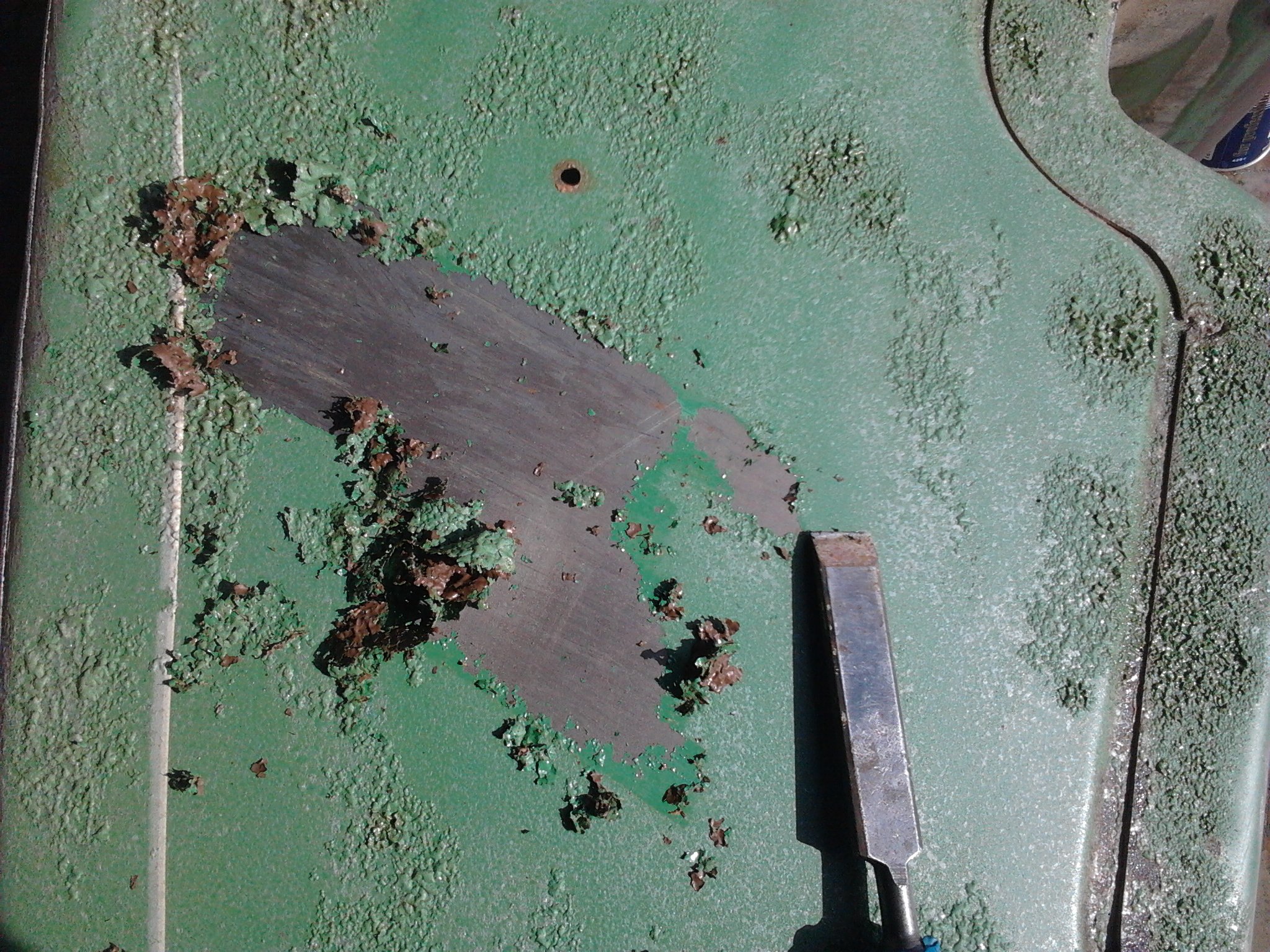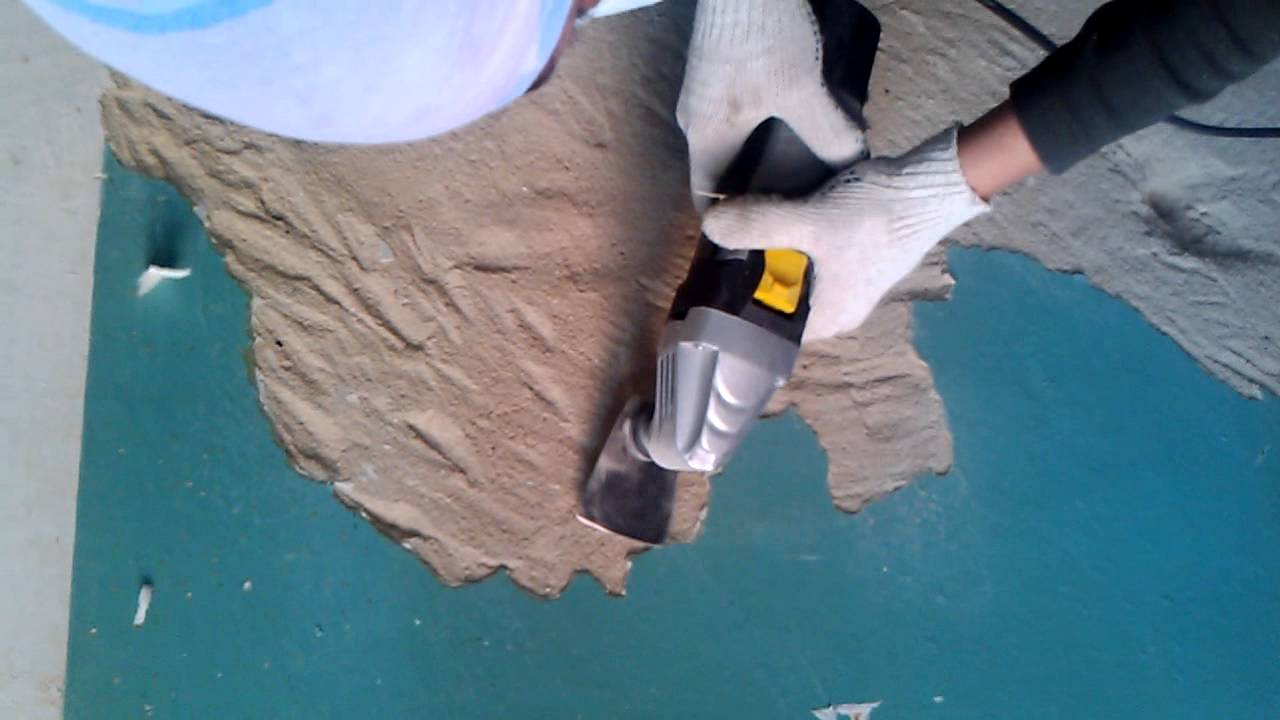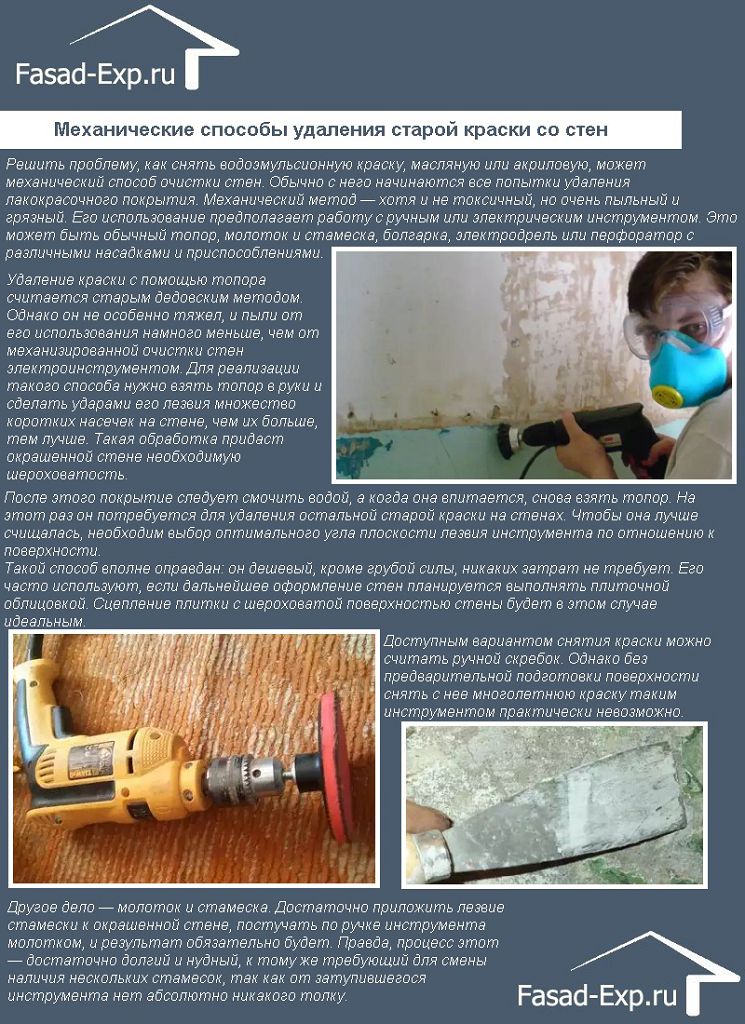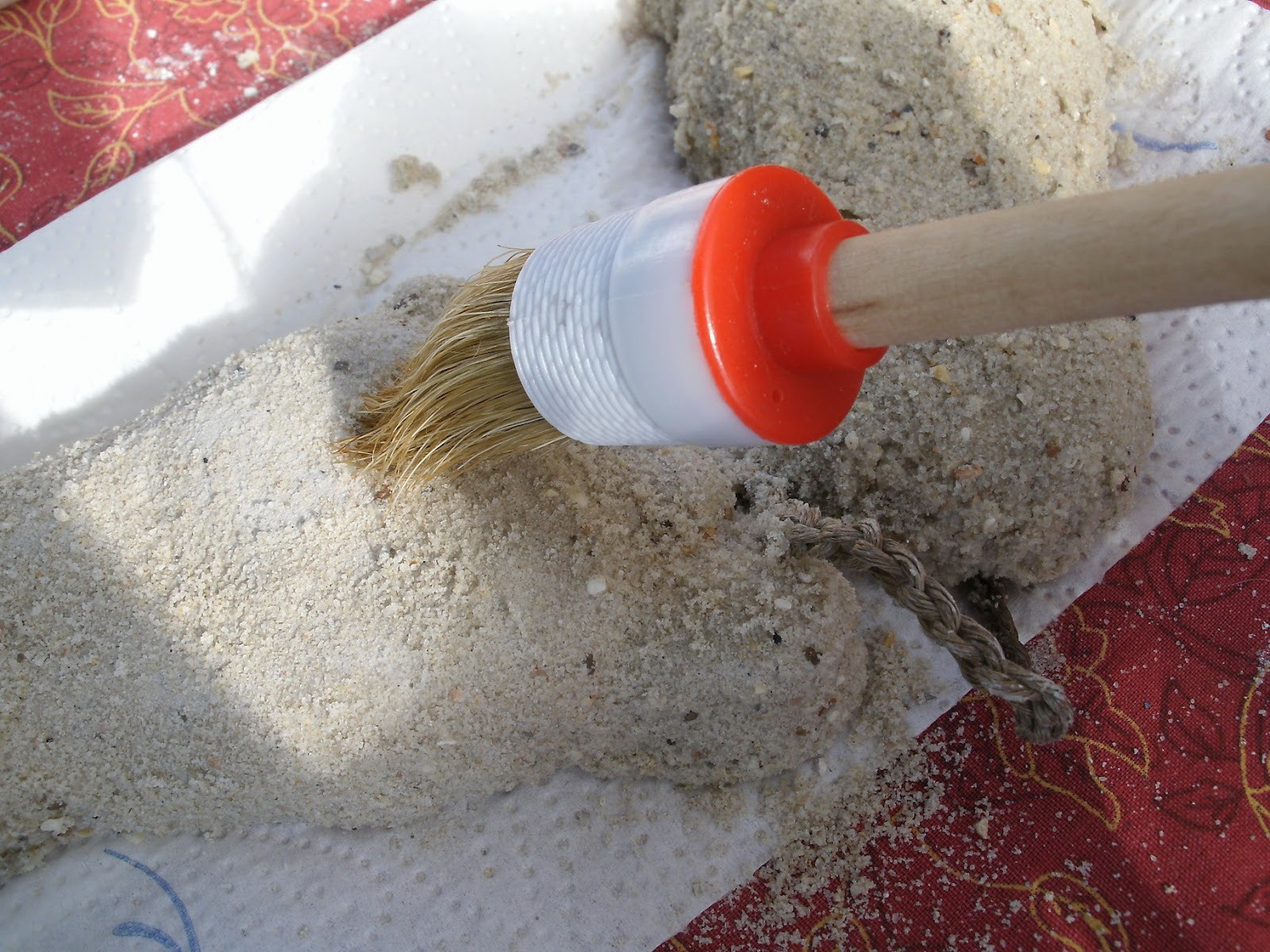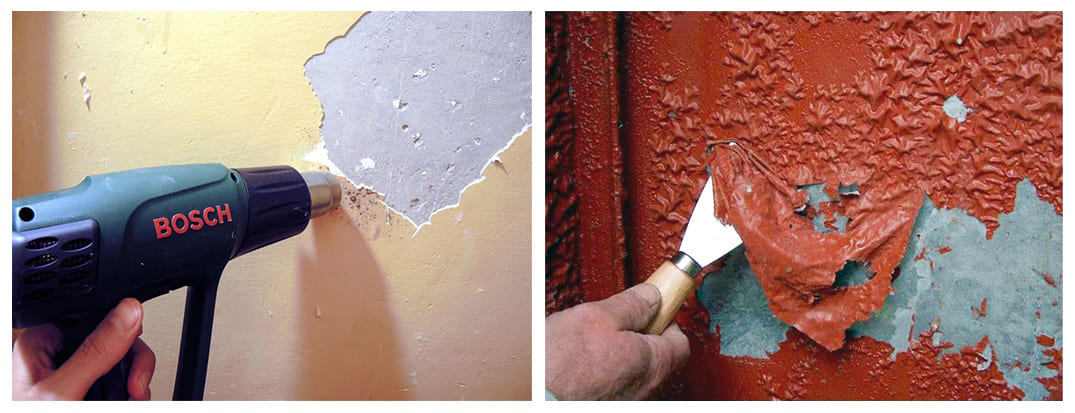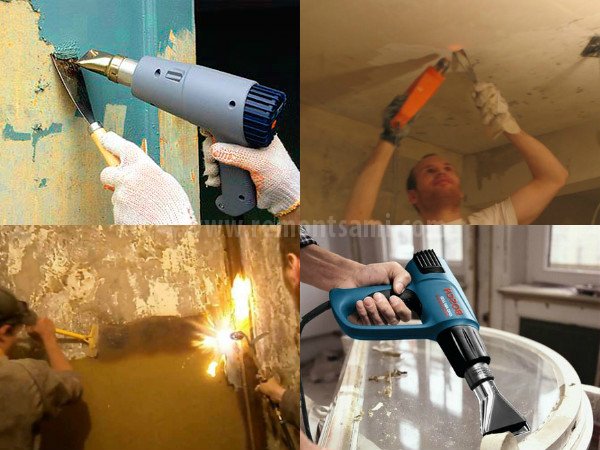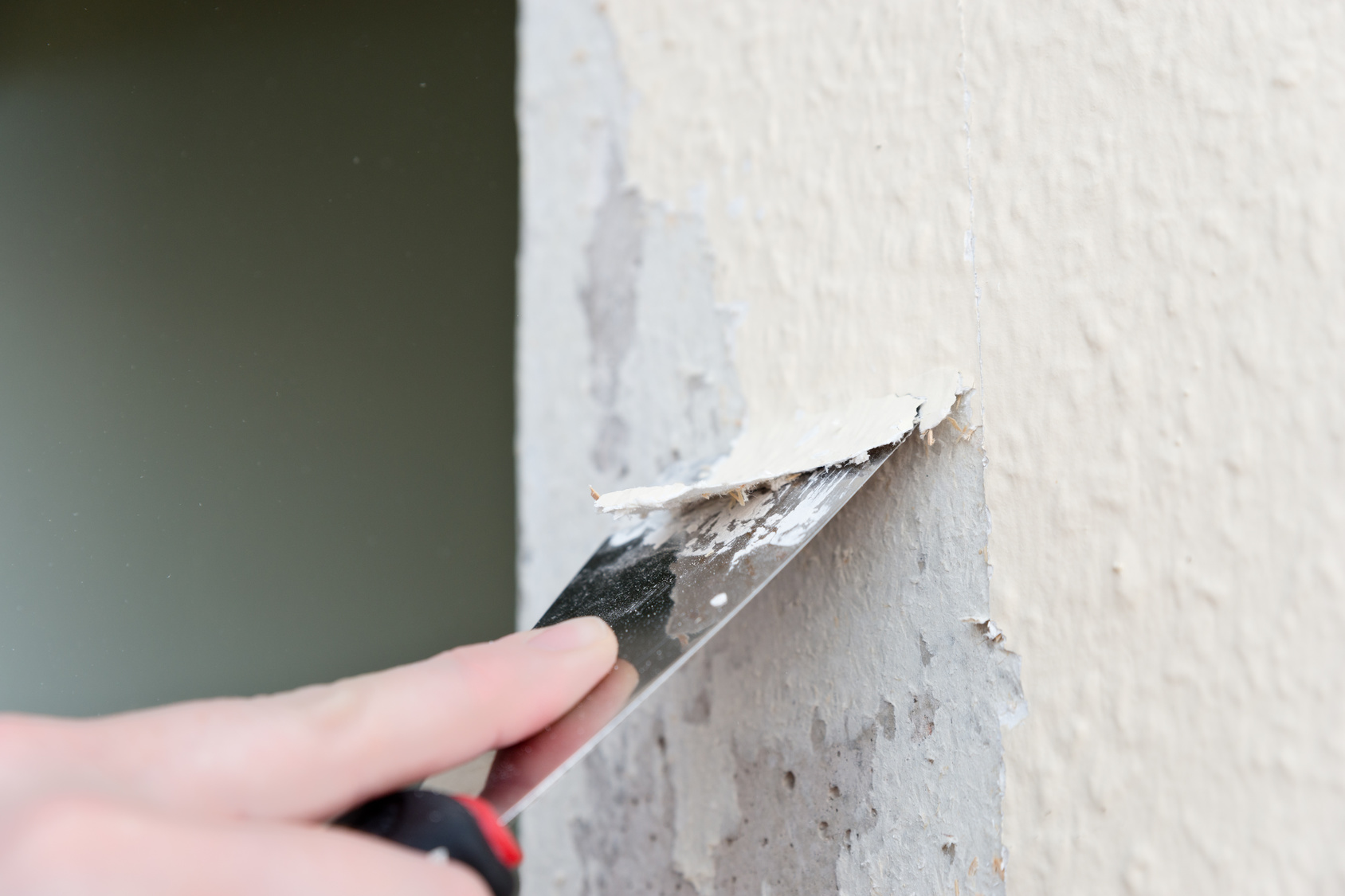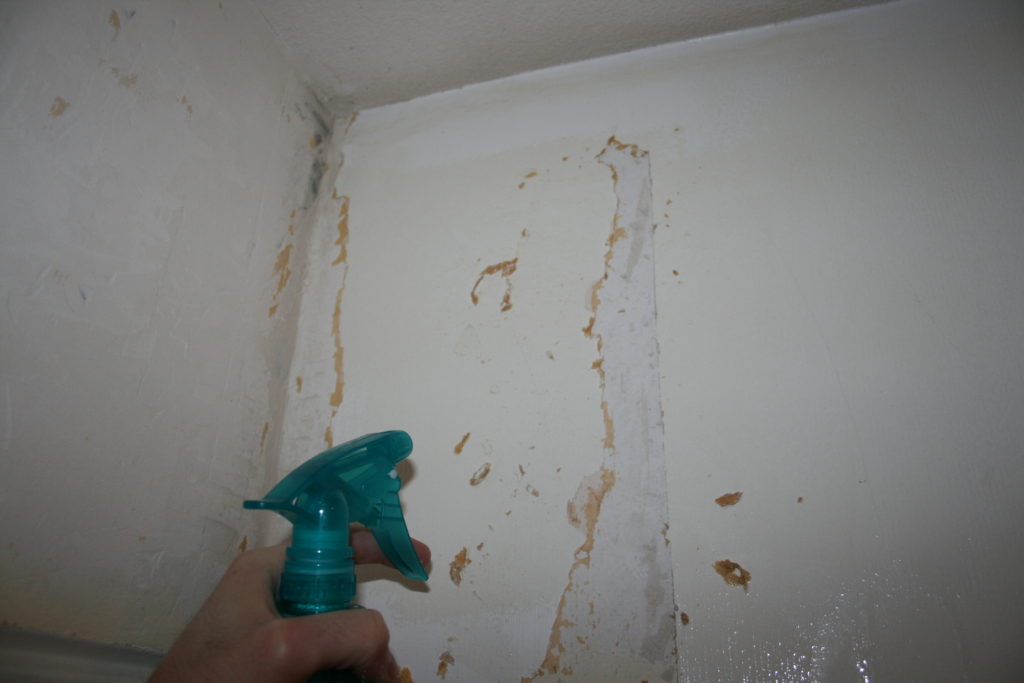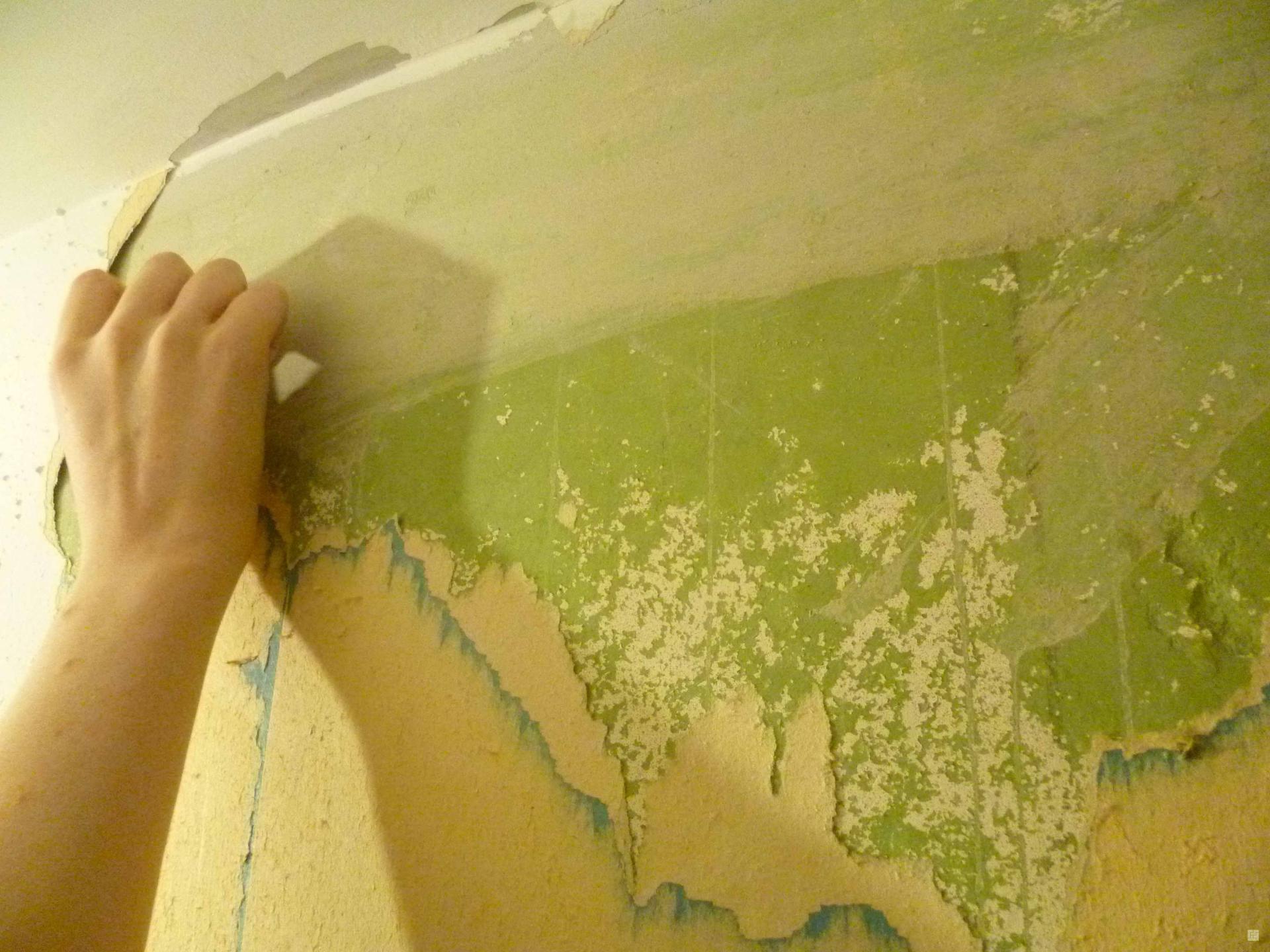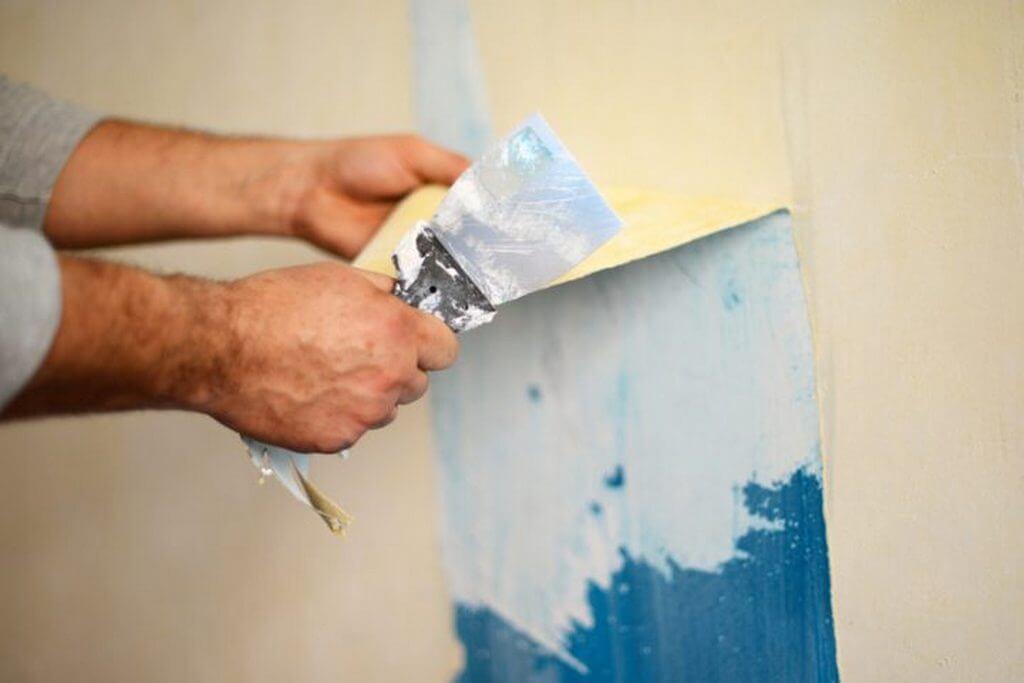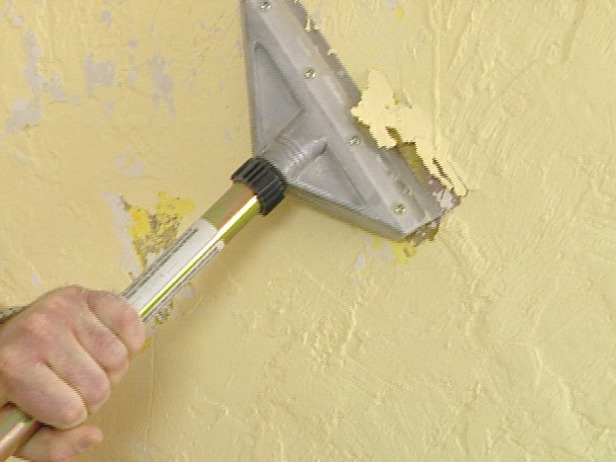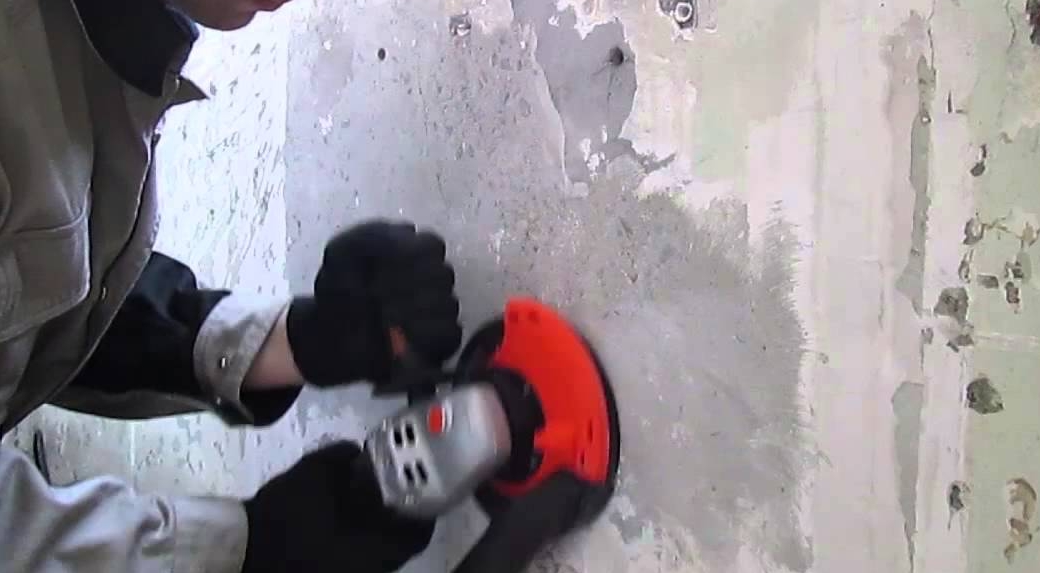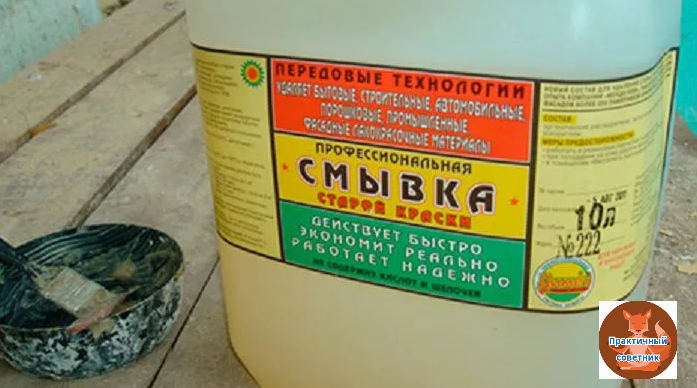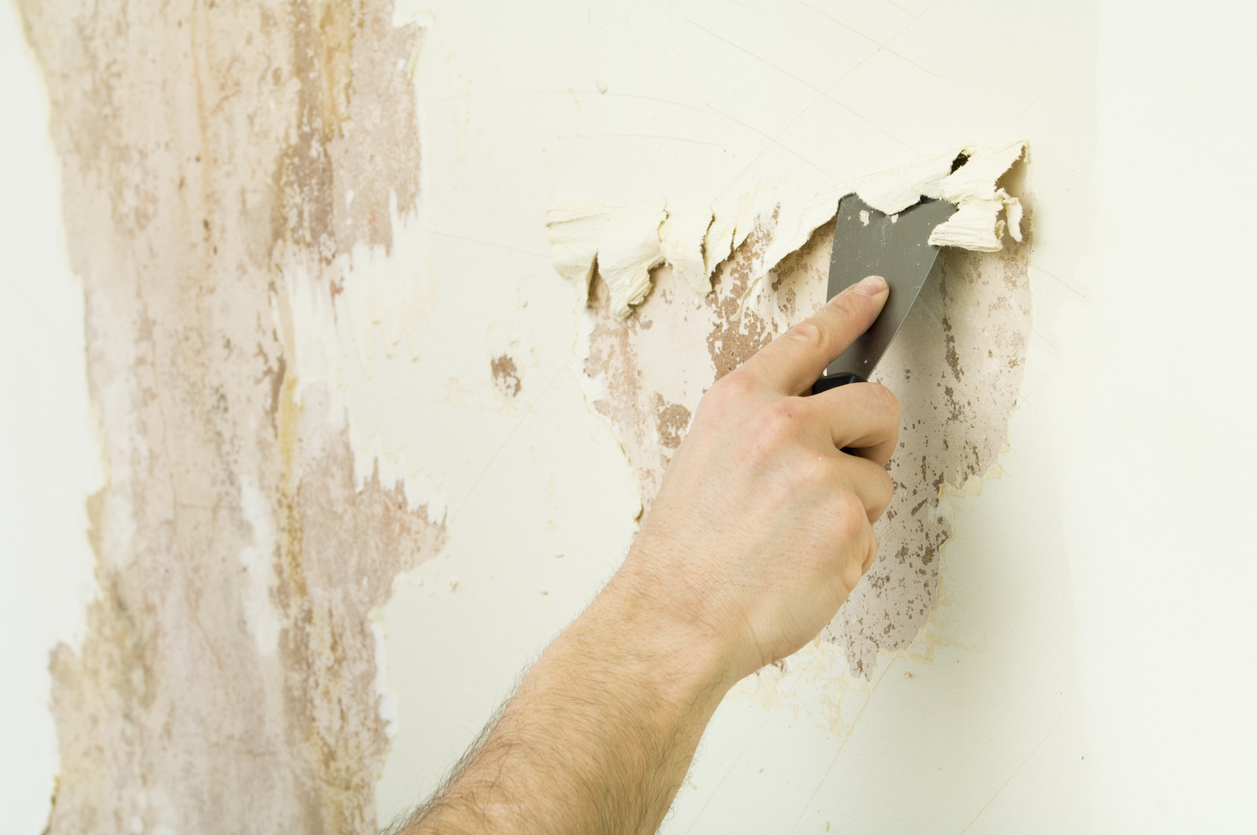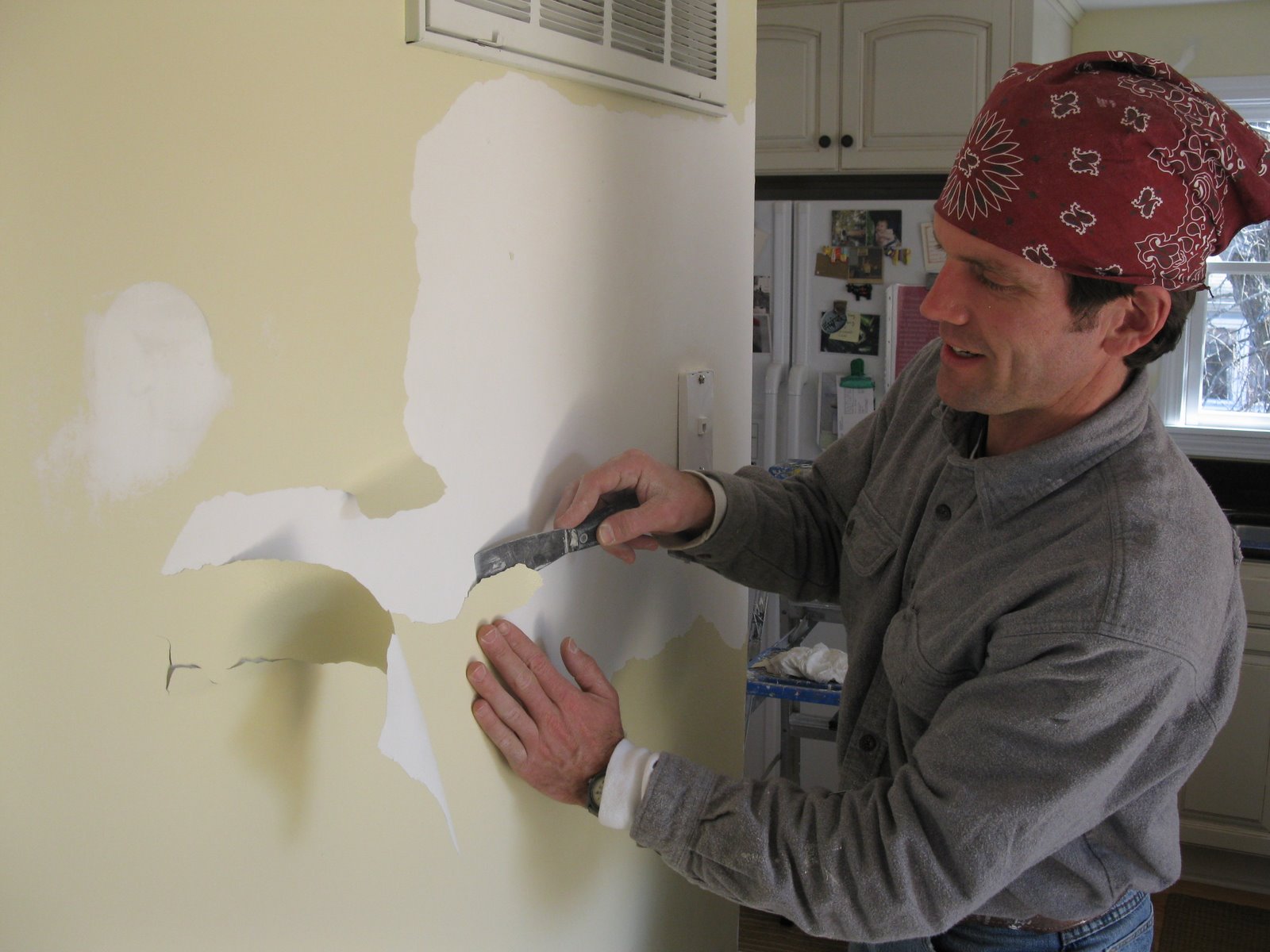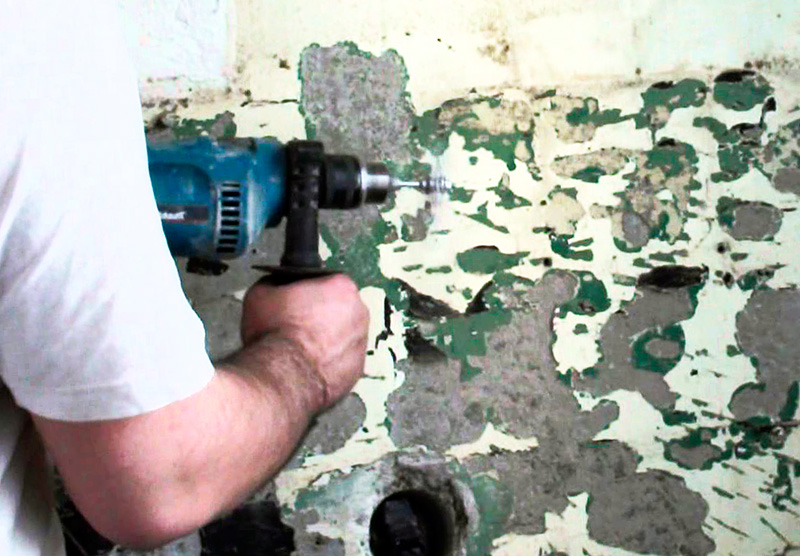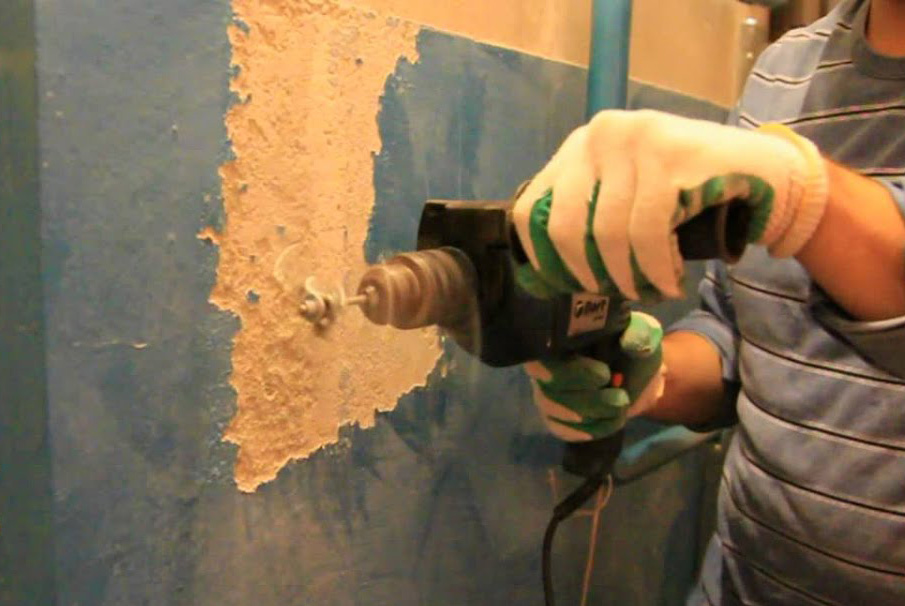Methods for removing oil paint
There are three ways to remove old paint from a wall:
- chemical;
- mechanical;
- thermal.
Mechanical method
The first thing that everyone begins to do, in front of whom there was a need to remove the old paintwork. On the positive side, it is non-toxic. Disadvantages - a lot of dirt and dust. Considering the disadvantages, in addition to the above-mentioned tools, a respirator and goggles should be available to avoid getting particles of the coating into the eyes and respiratory tract.
What does the mechanical method imply? This is cleaning the surface of a concrete wall with a grinder, supplemented with a wide nozzle, a chisel with a hammer (can be replaced with an ax), and an electric drill.
It should be noted that the ax was used as a tool for fighting old oil paint long before the invention of power tools.
The dust from working with it is much less, the risk of injury is minimal. In addition, you will have to put in a little effort.
How to work with an ax
The essence of work with a chopping object. With the help of an ax, the sharp part located at a slight angle relative to the wall, shallow notches are made on the surface. They should be short, but abundant. The main goal is to achieve a rough feeling. The next step is to spray the surface with water. The liquids should be allowed to soak, then the paintwork should be removed with an ax. For greater efficiency, you should choose the optimal angle of inclination of the ax blade.
It is also possible to mechanically clean the surface of the room from the paint-and-varnish coating with a hammer and a chisel. The principle of operation is similar to that used for the ax. It should be remembered that the chisel can become dull from frequent blows.
Work with a grinder
During work using the grinder, a lot of dust is generated. Typically, after a one minute treatment, you have to wait about 20 minutes for the dust to settle. This is why this tool is rarely used.
Using a drill
To remove paint using a drill, purchase one of three attachments:
- Ink Picker (3-chain design with 13 links each). Positive aspects of the work: the paint is removed in small pieces, without the formation of dust, the plaster layer (if any) remains intact. A relative disadvantage is that the chain breaks down during paint removal. It must be replaced as soon as three links remain on each side.
- Corset. It generates a lot of dust, although the effectiveness of the application is quite high.
- Crown nozzle. The best choice for concrete walls. Does not generate a lot of dust. Cleaning will take a lot of time and effort, but the result is quite high.
Chemical method
There are two types of wash:
- alkaline;
- organic.
Theoretically, the technology of work is as follows: the wash is applied to the surface for 10 minutes, then this action should be repeated several times. The paintwork should begin to peel away from the surface, after which it can be removed with a sharp trowel.
Peculiarities:
- The "older" the paint, the worse the chemicals will cope with it. The maximum age allowed is two years.
- Chemical vapors are hazardous. Therefore, during work, you should use protective equipment: glasses, gloves, respirators. Animals and other occupants, especially children, must be removed from the premises.
- It is better to carry out work in the warm season to ensure long-term ventilation in order to remove the unpleasant odor of the wash.
Thermal method
It implies the use of a special construction hair dryer. The method does not always seem appropriate. Concrete cannot be heated to the temperature at which the paint will begin to flake off.
Only wooden surfaces can be cleaned with it. When a jet of hot air hits the paint, it begins to become covered with bubbles, after which it can be easily removed with a spatula.
It should be remembered that the thermal method is not suitable for areas where wires and sockets are located. Also, a hair dryer is useless on a concrete wall.
The main disadvantage of heating is the release of odor (unpleasant and very caustic), as well as toxic substances. Therefore, the room must be thoroughly ventilated. The use of a respirator is also mandatory.
The heated coating should be removed quickly, otherwise the paint will bake and it will be impossible to clean it.
Chemical solutions
This method is more advanced. With the correct use of this method, there will be no more questions about how the old paint is removed. It aims to soften any type of paint and can be easily removed by means of construction trowels, brushes, scrapers.

In addition, chemical reagents can be prepared by yourself or bought in specialized hardware stores. The range of these funds is quite wide (type of alkaline or organic), but it is imperative to take into account the texture and age of the paint that needs to be removed.

The advantages of this method are the low use of physical strength, ease of use, very fast response and for all surfaces and types of paints.
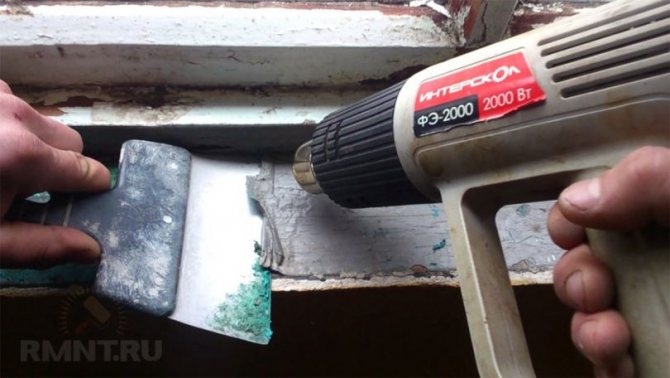
There are probably too many disadvantages, but if you carefully use the instructions for using the reagent, use the means that protect against certain influences correctly, work in a well-ventilated room, then the result will pleasantly surprise you!

-
Paint brushes: types, tips for choosing, application features and a review of the best brushes (100 photos)
- Paint roller: types, sizes, designs and tips for using a paint roller (video and 90 photos)
-
Fire retardant composition - types, tips for choosing and application features (85 photos and videos)
So, if you have purchased a chemical reagent, carefully read the instructions for use, wear gloves, a respirator, goggles, a suit that covers open areas of the body, allow the room to be constantly ventilated, or do work outside.

Now evenly, using a brush (a roller is also suitable), apply the solution and leave for the required amount of time. After softening the layer to be removed, remove the surface with a spatula, brush or scrapers. If some of the paint remains, repeat the manipulation again.
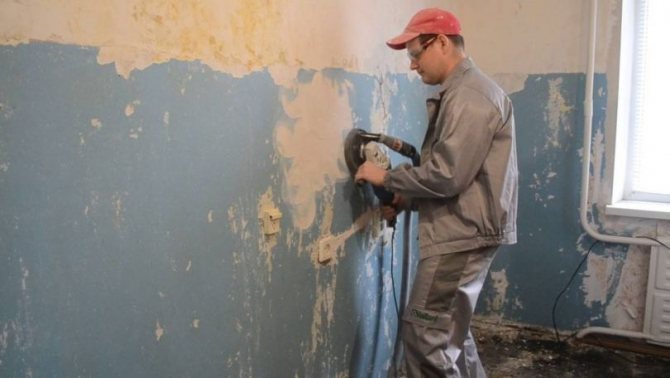
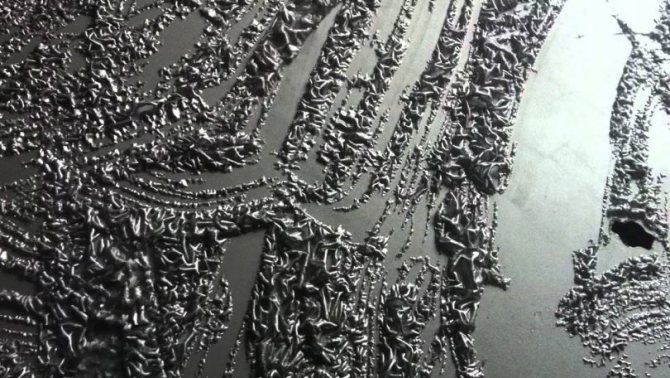
For example, if the surface (floor) allows, you can moisten it with plain water and generously cover it with soda ash, cover with damp rags on top, maintain the humidity of the treated surface for 24 hours and then, the swollen paint will be easily cleaned off under the action of a spatula.

Very often, an inventive people use a composition of three parts of quicklime and one part of soda ash, diluted in water to a thickness. It is enough to apply this mixture for twelve hours and then in the same way, with a spatula, remove the softened paint.

Some still try to use a liquid glass solution. It is bought ready-made, applied to the surface to be treated, allowed to dry completely, and, due to the properties of this substance, as a result, the hardened liquid glass separates along with the surface on which it was applied.
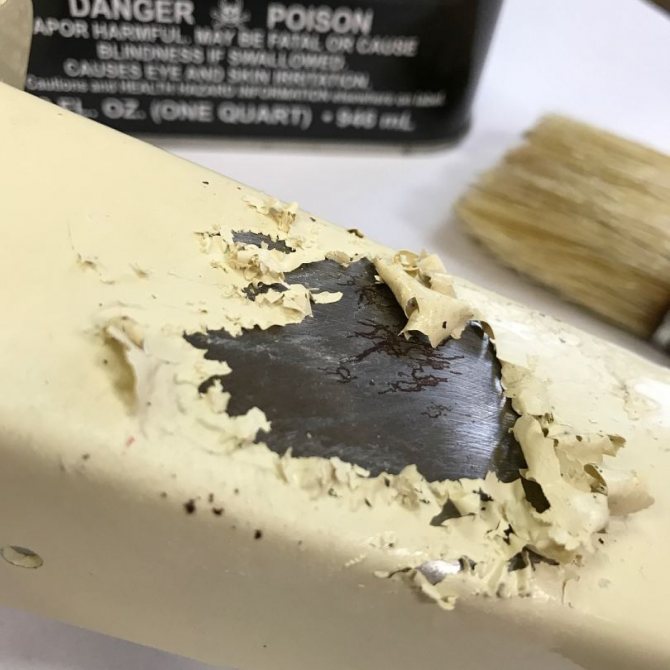
Thermal paint removal
This technology involves the use of available devices.The principle is that under the influence of high temperatures, the coating softens, after which it can be removed immediately. When using tools with an open flame, a scorching effect is created, due to which the paint burns, freeing the base for subsequent cleaning.
Thermal paint removal is based on the fact that high temperatures destroy the adhesion between paint and surface
Work order:
- The state of the area to be cleaned is assessed. If the structure can be easily removed, then it is better to dismantle it, this will allow the work to be performed more safely. If this is not possible, make sure that adjacent areas will not be exposed to high temperatures.
- All unnecessary is removed, if necessary, the adjacent surfaces are protected. For this, asbestos boards can be used.
- The item is thoroughly cleaned of dirt and dust, washed with water and dried.
- The heating device is being prepared. It is better to use a building hair dryer, as it is much safer than a gas torch or blowtorch. You also need to have a wire brush and a spatula. To avoid unpleasant consequences, protective equipment is provided: gloves, glasses, respirator.
- Heating is uniform. Initially, a large area is captured to make the coating easier to remove, then individual zones are warmed up. As soon as the structure of the removed layer becomes noticeably softer, a spatula or brush is applied.
- To achieve the best result, all movements should be interconnected and consistent: heating - removal.
- A solvent is used to completely remove residues. The main thing is that the base should not be very hot.
This method is suitable when you need to clean the oil-based coloring composition. Work is best done outdoors or in a constantly ventilated area.
Types of coatings
Depending on what kind of paint you have to work with, you will select the inventory and the option to deal with it
If we are talking about water-based paint, then it is important to know its specifics. This coating dries quickly, has no odor and, after drying, leaves a film that is difficult to remove from any surface.

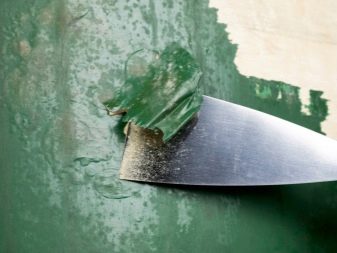
In order to remove such paint, you need to prepare tools, including: gloves, work clothes, respirator, masking tape, spatula, fluffy roller. When starting work, you need to prepare yourself and the room itself. To work comfortably, you need to free space from furniture, and place polyethylene on the floor
In order to remove water-based paint, it is important to moisten the surface with it with plain water. An iodine solution could be an alternative.
All this will allow the paint to soak and can be cleaned off with a spatula. If you succeed in this, then you are on the right track. When moisture or iodine is not absorbed into the walls and it is not possible to work, you need to approach from the other side. For waterproof paints, you will need a spatula and a hammer, these tools will work in the same way. If you find it difficult to work like this, you can use a construction hairdryer.
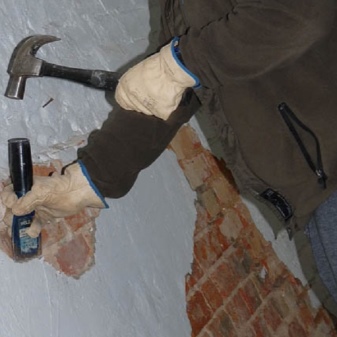

When working with him, it is important to protect the face and respiratory tract with a respirator. Using a hair dryer increases the risk of inhaling harmful paint fumes from walls and small particles
If you work with a spatula, but it does not clean off the paint, but simply slides over it, then you need to take a hammer and tap on the wall itself, and only then use the spatula.
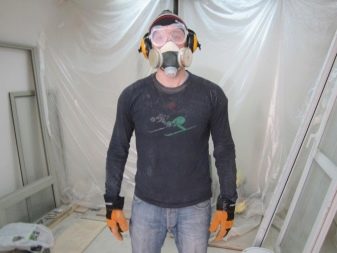
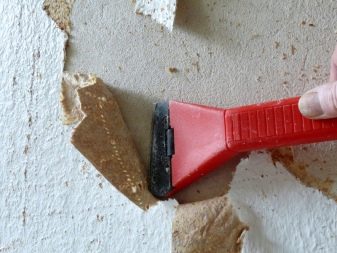
If the work is carried out on the ceiling surface, then in order to remove the water-based paint, you need to use a wash from the store, which in its composition contains potent substances that allow you to effectively deal with layers of old paint
For such work, it is important to open windows and doors so that there is natural ventilation in the room.
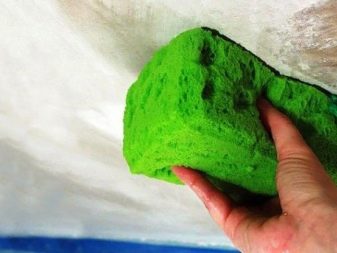

If you need to remove oil paint, then it is important to know the features of this coating. It is often used to decorate space.
Cleaning oil paint is often not easy and sometimes you have to apply a whole range of measures.
For work, you will need such tools: several spatulas with different sizes, rags, a wash with a strong chemical composition, a grinder, sandpaper, a soldering iron.
Hands are protected with gloves, and a respirator is put on the face. The chemical must be applied to the wall and left there for as long as the instructions suggest.
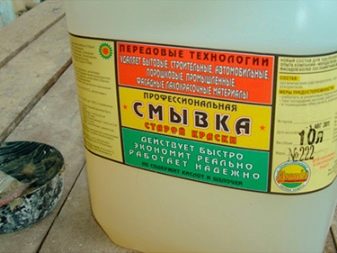

It will be possible to remove the remover along with the paint with a rag. If at one time you did not manage to remove the entire layer of paint, then you will need to repeat the procedure again. When the paint is already old and begins to crack, then it is removed with a spatula, the size of which is selected according to the situation. In difficult-to-clean areas, work is best done with a small spatula.
In the event that the spatula did not help, then you can take a building hair dryer. They will heat a small section of the wall, after which it must be cleaned immediately. The most effective work will be with two people - so that one heats up, and the second cleans the surface of the wall.
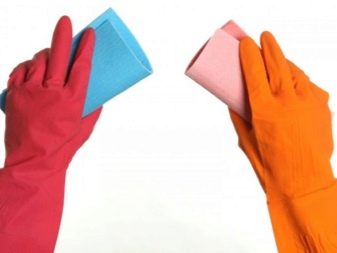
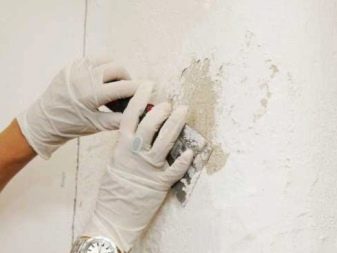
When working with a sander, the easiest way to remove the old layer of oil paint is by using a spatula in addition to the machine. You need to put on a nozzle with coarse sandpaper on the machine and start polishing the wall. The fewer layers remain, the thinner sandpaper should be used. This option, although effective, is very dusty.
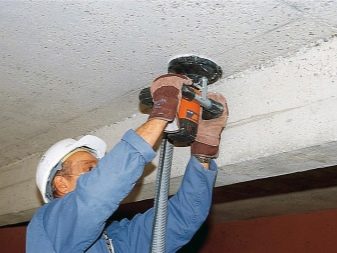
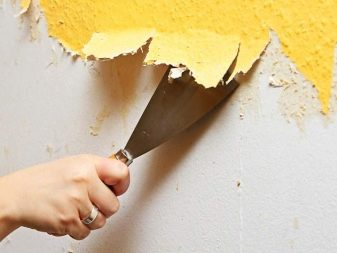
In the event that you have to clean the textured painting, then you can use any of the previously listed methods. An uneven coating will not make it possible to work comfortably with a spatula, therefore it is better for him to highlight an auxiliary role. The use of a water-based emulsion can also be used for textured wall decoration, which should immediately guide you on how and with what you will remove the old coating.
When you need to remove acrylic paint, the process will be a little easier and faster. You will need to take a metal bristle brush or sandpaper and actively remove the paint from the walls.
In this case, there will also be a lot of dust, therefore it is important to protect the eyes and respiratory organs.
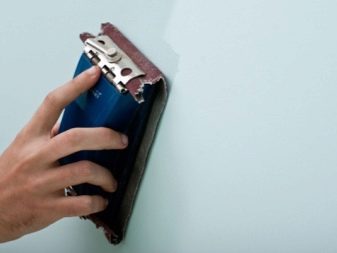
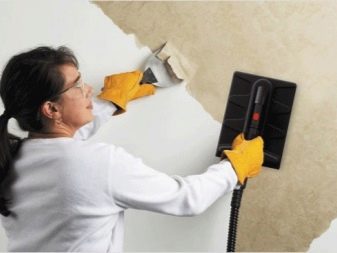
Methods for removing water emulsion from walls
For this event, various methods are used, each has its own advantages and disadvantages, but any work begins with the preparation of the premises. It is necessary to remove all unnecessary from the room, stationary objects, the floor and window openings are closed with cellophane. The door is hung, and the leaf is well wrapped with a suitable material.
After that, you can start the process.
The easiest way is to wash it off with water. Suitable for surfaces treated with compounds that cannot withstand prolonged exposure to liquids. To determine this, wipe a small area with a damp cloth. If dye remains on it, and there are traces on the surface, then it will be easy to wash off the layer.
Water allows small coatings to be cleaned in a short amount of time. The procedure is as follows:
- The container and liquid are being prepared. The water should be warm, this makes the process easier.
- During operation, the water will need to be changed several times, since it quickly becomes dirty. If this is not done, then the coloring composition will simply be transferred back and it will not be possible to achieve the desired result.
- A spray gun is used for application, it makes it possible to process a large area at once. The convenience of such a device also lies in the fact that the uniformity of processing can be controlled.
- The water is applied gradually. Wet areas become dark.
- After that, the sponge is moistened and the surface is wiped well. Movements should be accompanied by a slight pressure. Each place is processed several times. In this case, the sponge is periodically squeezed out.
- If the coating is removed poorly, then a spatula comes to the rescue - it is used to clean off difficult areas. It also comes in handy for corners.
This method avoids a lot of dust. But due to the fact that the work is accompanied by drips that cannot always be controlled, the plinth area needs special protection to prevent damage to the floor.
Soap solution
When deciding how to wash water-based paint, another simple option is taken into account, it is similar to the previous one, but a soap solution is used. This composition allows you to work on coatings that have been treated with several layers of water emulsion.
- Soap or washing powder (preferably fragrance-free) is diluted in warm water until a copious lather is obtained.
On a note! Working with soap is much easier if you grate it or scrape it off with a knife.
This method also requires constant water changes and requires more thorough rinsing so that no soapy film remains.
Mechanical method
To remove water-resistant paint, a mechanical method is used. It includes two options that differ in the method of exposure:
Removing the composition with a spatula and hair dryer. This technology is more suitable for oil and alkyd paints, but can be used for water-based formulations in which vinyl and acrylic are present. The base is heated with a hairdryer, the area is immediately processed with a spatula, the heating does not stop. For convenience, the wiper should be in the main hand and the hair dryer in the other. This allows for continuity. But this option does not always give the desired result, because the water base complicates the process.
Removing paint with a drill with a special nozzle is a quick and trouble-free method, albeit very dusty
On a note! Sometimes the question arises of how to wipe off the water-based composition from the places where it got accidentally. If the solution is fresh, then it is washed off with plain water; in case of drying, a suitable tool is used. For example, the impact on plastic should be minimal, so the hard side of a dish sponge or a wooden spatula is used to clean it.
Paint remover
Remover for water-based paint is used in cases where there is not enough time or work is carried out on the street. The fact is that this tool is a special chemical solution, which, due to reagents, affects the composition of the coating. This allows you to get excellent results.
But the wash is harmful to health, so work is carried out in well-ventilated rooms with the necessary precautions.
The mixture in the right amount is applied to the base and left for the specified time. Bloated paint is removed with a spatula, after which the entire surface is rinsed with warm water.
This option is great for cleaning wood or drywall, which are easily damaged by other methods. The main thing when choosing is to familiarize yourself with the manufacturer's recommendations, because some formulations are not suitable for certain wall materials.
In special cases, special treatment is required to minimize chemical attack.
Mechanical restoration
When figuring out how to remove old paint from wood surfaces, the simplest method is often chosen. It comes down to mechanical removal of the paint layer. There are several ways to do this. The structure of the material should be evaluated first. If the wood is soft, abrasive particles from the tools will destroy the product.
 When using any mechanical method, do not apply too much pressure to the tool.
When using any mechanical method, do not apply too much pressure to the tool.
Processing the product with sandpaper
Sandpaper allows you to quickly erase the old coating. But it is suitable for a thin layer. Repeated staining will not completely remove the sandpaper. Also not suitable for difficult places on the product.
The technology for using sandpaper consists of the following steps:
- Prepare sandpaper.You will need several sheets of different grain sizes.
- Begin by processing with coarse sandpaper. This will remove the top layer.
- They change the coarse grain to a finer one and clean the wood with such sandpaper. The treatment is carried out until the surface is smooth.
To facilitate the process, it is recommended to take a bar and wrap it with sandpaper. It's more convenient to work this way. The advantage of this method is the low probability of damage to the product and the availability of tools.
To facilitate the process, it is recommended to take a bar and wrap it with sandpaper.
Cleaning the product with an angle grinder (angle grinder)
The sander cannot be turned on at full power when used in this case. It can damage wood. It is recommended to use the petal nozzle to quickly get rid of the old paint layer. The workflow is simple. You need to take a stable position, take the tool with both hands so that it does not slip out, and proceed to surface treatment. Particles of paint quickly clog the discs of the typewriter. Therefore, it is necessary to change them regularly. When the last layer of paint appears, it must be removed by hand. To do this, use sandpaper. The resulting dust can be wiped off with a cloth previously moistened with water.
 The sander cannot be turned on at full power when used in this case.
The sander cannot be turned on at full power when used in this case.
Using a drill
The drill must be kept perpendicular to the wood during processing. The movements are not sharp, smooth and accurate. Efforts should be made slowly and gradually. Particles of paint can fly in different directions. Therefore, when choosing this method, it is imperative to use safety glasses. In order not to damage the product, it is recommended to use special grinding attachments.
 The drill must be kept perpendicular to the wood during processing.
The drill must be kept perpendicular to the wood during processing.
Stiff paint brushes
When using a stiff brush, the workpiece must be taken out into the street. If this is not possible, all surrounding objects and surfaces are wrapped and covered with polyethylene.
This method consists of the following steps:
- Notches are made on the product with an ax. The wood is moistened with water and left for a couple of minutes so that the liquid is absorbed.
- The surface is treated with a metal brush, removing the upper painted layer. To maximize the effect of the process, it is recommended to keep the instrument at an angle to the workpiece.
- The bottom paint layer is removed with sandpaper.
This method is often used for processing doors and window frames.
 When using a stiff brush, the workpiece must be taken out into the street.
When using a stiff brush, the workpiece must be taken out into the street.
Solvent selection
Most plastics withstand mineral solvents well. There are several effective formulations for getting rid of paint. It's worth understanding each method.
 Most plastics withstand mineral solvents well.
Most plastics withstand mineral solvents well.
How to remove with acetone
The composition is used in combination with ammonia. First, acetone is applied to a napkin and the surface is treated with it. The ammonia is applied to a sponge and covered with plastic on top. Leave for a couple of minutes and wash off.
 The composition is used in combination with ammonia.
The composition is used in combination with ammonia.
Wash off
When working with the wash, be sure to use a respirator and gloves. It is recommended to arrange good ventilation in the room in advance. The wash is poured into a suitable container and the plastic is immersed there for several hours. To increase efficiency, the surface is brushed to remove paint residues.
If the plastic cannot be immersed in the container, the wash is applied to it with a brush. The main thing is that the liquid does not dry out.
 When working with the wash, be sure to use a respirator and gloves.
When working with the wash, be sure to use a respirator and gloves.
How to remove brake fluid
The immersion method is used. The brake fluid is poured into a container, the plastic is immersed in it for 30 minutes. Residues of paint are removed with a brush. You can also apply brake fluid to the problem area with a rag.
 The immersion method is used.
The immersion method is used.
"Mole"
Helps not only deal with blockages, but also paint coating. It is enough to cover the desired area with them and leave for 30 minutes. Dissolved paint is removed with a brush.
 Helps not only deal with blockages, but also paint coating.
Helps not only deal with blockages, but also paint coating.
Methanol
The plastic is either immersed in methanol or coated onto the surface. It is recommended to keep the composition for a maximum of 15 minutes. The substance is corrosive. Be sure to use gloves and a respirator. Additionally, arrange for good ventilation in the room.
 It is recommended to keep the composition for a maximum of 15 minutes.
It is recommended to keep the composition for a maximum of 15 minutes.
Degreaser, white alcohol
The composition is applied to the surface and left for 15 minutes. Clean with a brush. Finally, the surface is rinsed with clean water.
The composition is applied to the surface and left for 15 minutes.

